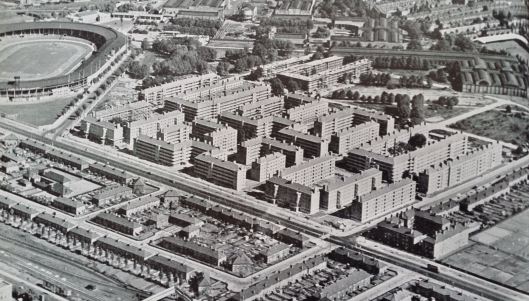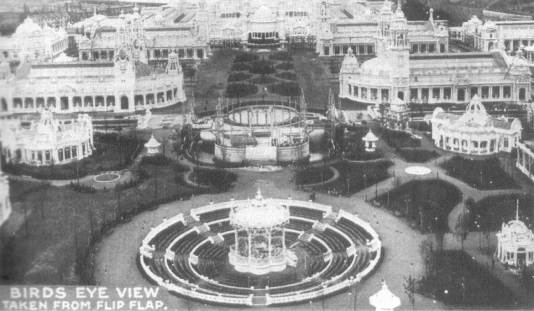Tags
Last week’s post examined the origins of the White City Estate at a time when the state’s role in providing decent homes for working-class people was firmly embedded. Those ideals remained – and can be seen in the further development of the Estate – long into the post-war era but from the 1970s there were some who argued council housing caused rather than alleviated poverty. The Estate would become a site of this struggle and even today – as its ongoing regeneration continues – it’s a symbol of how far contemporary ideas around the form and character of social housing have shifted from the earlier model pioneered by the London County Council (LCC).

‘Air view of the White City Estate, Hammersmith’ from The County of London Plan (1943) – showing the Estate as completed by 1939
Originally, the intention remained to improve the design and facilities of council estates. Hammersmith Park, built on the site of the Japanese Garden created for the Japan-British Exhibition of 1910, was reopened for the benefit of White City residents with added tennis courts and playground in 1954. More recently, it has become a mark of our changing values when, in 2013, the then Conservative-controlled Borough of Hammersmith and Fulham proposed to lease half the park to Play Football, a private company intending to let pay-to-play facilities. Some form of compromise appears to have been reached but one which will, nevertheless, see free public facilities hived off to the private sector. (1) Given the swingeing cuts to local authority budgets, the incentive – hard-pressed councils might argue the necessity – to monetise community assets will continue. (2)

Malabar Court
While the White City Estate was substantially complete by the early fifties, the neighbourhood shows the continuing attempts to modernise and adapt council housing to changing times. Malabar Court (at the corner of India Way and Commonwealth Avenue) was designed by Neil Moffett and Partners as sheltered housing for elderly people and opened in 1966. A ‘pile of ascending hexagons’, Pevsner thought it a ‘welcome respite’ to what he considered the dull uniformity of the rest of the Estate. (3)

White City Close
The small White City Close (or Wood Lane) Estate, east of White City just north of Television Centre, shows how far thinking around council house design had evolved by the 1970s. In a conscious reaction to the high-rise boom of the 1960s and overbearing scale of some earlier local authority schemes, White City Close was designed as a compact series of two- to four-storey brown-brick terraces enclosing landscaped footways and courts. Designed by John Darbourne and Geoffrey Darke and opened in 1978, it’s a little echo of their earlier and successful Lillington Gardens Estate designed for Westminster City Council and their far more troubled (and since largely demolished) Marquess Estate built by Islington in the late seventies.
In 1981, ownership and management of the White City Estate was transferred to Hammersmith and Fulham Council from the Greater London Council but by the 1990s the Estate and its community had fallen on hard times. In 1996, the Council (under Labour control from 1986 to 2006) successfully applied for an £8m grant from the Government’s Single Regeneration Budget to revive the Estate.

Commonwealth Avenue
Environmental improvements, housing upgrades and a renovated health centre followed but, if subsequent reports are to be believed, much remained to be done. According to the Evening Standard in 2004, the Estate was ‘a blighted area where nobody wants to live’. The rest is a masterclass in the demonising journalism which has so influenced perceptions of council estates in recent decades: (4)
When a man in a suit parks outside Canberra Primary School’s double-height wire fence, he cannot punch in the keypad security code and slip through the school’s fortified gates quickly enough. Three blonde, pony-tailed girls pushing baby buggies display a similar heads-down, no looking left or right attitude, as they walk between the estate’s redbrick, five-storey blocks of flats. Nobody lingers on White City’s streets. Only a shuffling, middle-aged Asian man wants to chat, offering me a cigarette from an empty Marlboro packet. “You live here?” he asks as I edge away. ‘No, just having a walk.’
One feels for the friendly (though ‘shuffling’) Asian man. One wonders if the three young women with babies took such a hostile view of this stranger as she apparently took of them. But, if you want to paint a picture of depressing anomie, the journalist had pressed all the right buttons. Was it simply her brief or was she herself a product of how so many who didn’t live in council housing had been conditioned to understand it?

Champlain House
Five years later (and with, to be fair, some evidence of renewal taking place), rather more seasoned observers took a different view. The Estate appeared – in contrast to earlier reports – ‘to be well provided for in terms of community facilities and amenities’ and ‘well maintained with evidence of repairs and maintenance work underway as well as new building’. (5)
Residents’ views were mixed. Most would not recommend the Estate to others; some definitively (‘Not at all. Nothing to like about it’) but many rather more equivocally, as if reflecting how outsiders perceived the Estate as much as than their own experience:
It depends on what you’re looking for – for people who’ve got nowhere else to go it’s okay and they are upgrading it a lot, they are really doing a lot of work to it…
I love it. It’s where I know, I’ve seen it over the years. It’s my home…
I’ve been here twelve years so I like it but maybe it’s not for everyone, particularly if they want a house or need more space than these flats.
In general, the Estate’s actual residents ‘offered quite a balanced view’ of the Estate; some praising its quietness and convenience, many agreeing that young people in particular were poorly served.
Hard data provides another perspective. By 2009, in terms of household income, White City was ‘among the most deprived areas of the whole country’, parts of it in the bottom five per cent nationally. Three years later, another set of statistics gives chapter and verse. Across the wider White City area, 29 per cent of households were single adults and 15 per cent lone parent with dependent children. Members of ethnic minorities (mainly Black African, Somalian and Eritrean, and Black Caribbean) were also disproportionately represented, forming 46 per cent of the total. Twenty-eight per cent of the population were under 18. (6)

Hudson Close
The point, of course, is not that these groups are the ‘problem’ but that they are the groups most likely to suffer problems. To some extent, there was a continuity here; some had seen the Estate as ‘blighted’ from the outset by the large proportion of former slum dwellers who made up its first residents. Then most were probably in employment. In 2012, 29 per cent of the Estate’s working-age residents received Income Support, Job Seekers Allowance or Employment and Support Allowance or Incapacity Benefits.
This reflected, of course, the residualisation of council housing that has occurred since the 1970s – the fact that it is increasingly confined to those with the most pressing and urgent needs. This, in a sense, was an issue recognised by Stephen Greenhalgh who led Hammersmith and Fulham’s Conservative Council from 2006 to 2012: (7)
Social housing was meant to help lift people out of the slums. Instead many social housing estates have become the very ghettos of multiple social deprivation that they were supposed to replace.
‘Ghettos’ isn’t a very nice word but we might see some truth in this statement. Greenhalgh’s starting point, however, was that social housing was now ‘welfare housing where both a dependency culture and a culture of entitlement predominate’.

The view of Greenhalgh and Moss, Principles for Social Housing Reform. Question the labels and ignore the arrows.
There are two difficulties with this. Firstly, straightforwardly, it caricatures estates and their communities. On the White City Estate (where 74 per cent of occupants remained council tenants), local Labour councillor Jean Campbell articulated some of the anger and insult felt by local residents: (8)
My community on the White City Estate is a vibrant one. My neighbours include people working in health care, people working as police officers or people who are simply doing their best to bring up their kids and look after their families.
Secondly, it reverses cause and effect. Council housing is no longer seen as a response to social problems – the ‘safety net’ that even its minimalist advocates recognise – but one of their causes. In one leap, Greenhalgh moves from correlation – the reality that many poorer people do live in council housing (for all the reasons of public policy that this blog has charted and because, fundamentally, they have been failed by the free market) – to causation.
To do so, of course, suits a free market agenda ideologically opposed to state intervention in all its forms which is seen in his astonishing solution to these alleged difficulties. Greenhalgh recommended that social housing rents should rise to market levels and that a single form of (so-called) Assured Tenancy – assured for six months – should operate across private and public rental sectors. Documents secured by Hammersmith’s Labour MP Andy Slaughter under Freedom of Information legislation revealing a 2009 meeting between Greenhalgh, Eric Pickles and Grant Shapps (then shadow Ministers of Communities and Local Government and Housing respectively) show the influence of this radical thinking upon the incoming Conservative government. (9)
Unsurprisingly when the Conservative-Liberal Democrat coalition government’s 2011 Localism Act gave social landlords the right to introduce fixed-term tenancies, Hammersmith and Fulham were among to signal their acceptance of the offer, proposing five year tenancies for most but as little as two years for others, especially those under 25. It wanted, apparently, ‘to incentivise residents to make the most of the their lives’. That actual tenants ‘better able to predict their housing future…reported being better placed to manage other challenges in their life’ (including employment) was not considered. (10)
Whilst the hard-core radicalism of that agenda has not yet been implemented, it was previewed in 2012 when the plans of Hammersmith and Fulham Council to relocate 500 of the Borough’s homeless families on benefits to the Midlands – to move them to rented accommodation elsewhere rather than prioritise them for local council housing. Tory Hammersmith wanted to favour ‘wealth creators’ rather than the ‘workless and dependent on benefits…not making a contribution that could help drive economic growth’. (11)
This was linked to a voluntary and accelerated programme of selling off council homes by Hammersmith and Fulham: of 256 homes sold between April 2011 and December 2013, 46 went through Right to Buy and 210 were sold at auction, mostly through Savills. (12) The phrase ‘social cleansing’ might be overused but here it seems justified.
A surprise victory by the Labour Party in the 2014 Borough elections – the Party gained 11 seats and took control of the Council – has put paid to the most far-reaching and ideologically-driven of these proposals but they exist, of course, on a spectrum and ‘regeneration’ – in Hammersmith and across London – continues to be controversial and, in many cases, a threat to established communities. (13)

This view towards central London shows BBC Television Centre to bottom left and the Westfield shopping centre under construction
There should be nothing controversial in desiring and assisting the economic uplift of an area. The White City Opportunity Area was first mooted in 2004 and has received broad cross-party support since then. The project’s initial ‘Framework for Development’, produced jointly with the Greater London Authority, contains the laudable ambitions of most such documents: (14)
By the end of the decade, the White City Opportunity Area will have been transformed into a thriving new, mixed use urban quarter of the highest quality, with a strong sense of place and local identity shared with the surrounding community…The area will be recognised as an exemplar of sustainable urban development, successfully combining strategic and local aspirations.
It was also clear that in housing terms, ‘social rented accommodation should predominate and there should be affordable key worker housing’.
In later iterations, the emphasis has shifted to ‘affordable’ housing and most of you reading this will know that that is a very shifty term indeed – Boris Johnson, the former Conservative Mayor of London defined it as 80 per cent of market rates. In 2013, the broad goal was ‘to increase housing choice’ in ‘White City West’ (including the Estate) and to ‘enable estate renewal and seek a mixed and balanced community’. (15) If Greenhalgh represents the most extreme position, a broad critique of mono-tenure council estates has achieved wider political agreement.

An artist’s impression of the Westfield Centre and new housing
Back in 2004, it was projected optimistically that the regeneration of the White City area – the BBC Media Village, the Westfield shopping centre (opened in 2008 and currently being extended), the ongoing development of a new Imperial College campus, and more – might create 11,000 new jobs. Training schemes for young people were part of the package.
Typically, these were concentrated in the retail sector whilst the London Development Agency promoted a scheme ‘to train the estate’s 30 per cent unemployed to fill hospital jobs such as receptionists, ward clerks and security guards’. Mark Billington, Hammersmith and Fulham Council’s head of employment initiatives, was quoted as saying ‘Life is easier if employers tell us exactly what the skills they need are, and what type of people they want’. (16)

You can draw your own conclusions here but, given that almost one in three of the White City Estate’s working-age residents remained jobless eight years later, the impact has been less than hoped. One wonders too how many of these relatively unskilled and non-unionised jobs are on zero-hours contracts.
Welcome to the new world. The White City Estate was born into an era of full employment where secure and decent homes were viewed as the necessary accompaniment to secure jobs. Now it seems that insecurity is seen as the necessary corrective to some perceived failure of personal enterprise and the market must rule.
Sources
(1) The Shepherds’ Bush Blog, ‘Reprieve For Hammersmith Park?’, 28 March 2014
(2) This is well documented in Tom Crewe, ‘The Strange Death of Municipal England’, London Review of Books, 15 December 2016
(3) Bridget Cherry and Nikolaus Pevsner, London 3: North West (1991)
(4) Susan Gray, ‘Great White Hope; What hope is there for a blighted area where nobody wants to live?’, Evening Standard, 22 March 2004
(5) Laura Lane and Anne Power (LSE Housing and Communities), Low income housing estates: a report to Hammersmith United Charities on supporting communities, preventing social exclusion and tackling need in the London Borough of Hammersmith and Fulham (September 2009)
(7) Stephen Greenhalgh and John Moss, Principles for Social Housing Reform (Localis, 2009)
(8) ShepherdsBushW12.com, ‘Council Plotting to Get Rid of the Poor’, MP claims housing plans are ‘Shirley Porteresque’, 9 July 2009
(9) ‘Not Decent! The Evolution of Radical Tory Social Housing Policy: Full extracts from documents supplied by Hammersmith & Fulham Council in response to an FoI request from Andrew Slaughter MP’. These documents can be found on the website of the site of West Ken and Gibbs Green – a Hammersmith and Fulham residents’ group fighting proposals to demolish their own Earls Court estate.
(10) Hammersmith quotation and residents’ views from D Robinson and A Walshaw, ‘Security of Tenure in Social Housing in England’, Social Policy and Society, vol 13 no. 1, January 2014. The damaging effects of insecurity of tenure are also discussed in John Bone, ‘Neo-Liberal Nomads: Housing Insecurity and the Revival of Private Renting in the UK‘, Sociological Research Online, vol 19, issue 4, 2014
(11) Randeep Ramesh, ‘Tory borough plans to move homeless away from London’, The Guardian, Wednesday 2 May 2012
(12) Dave Hill, ‘The great Hammersmith and Fulham council house sell off‘, The Guardian, 19 May 2014
(13) In Hammersmith, this is particularly true of the Earls Court scheme (mentioned in footnote 9) which has been extensively charted by Dave Hill in the Guardian.
(14) Hammersmith and Fulham Council, White City Opportunity Area: A Framework for Development (adopted 2004)
(15) Greater London Authority, Opportunity Area Planning Framework: Second Public Consultation, June 2013
(16) Susan Gray, ‘Great White Hope’






 almost qualify for the house-agents’ description ‘luxury flats’. They are approached by internal staircases, each of which has a dust-chute for disposing of rubbish. The flats with three, four or five rooms each have their private balcony, with permanent concrete window boxes. The kitchen has direct access to the living room through doors which slide wide apart.
almost qualify for the house-agents’ description ‘luxury flats’. They are approached by internal staircases, each of which has a dust-chute for disposing of rubbish. The flats with three, four or five rooms each have their private balcony, with permanent concrete window boxes. The kitchen has direct access to the living room through doors which slide wide apart.






 I want to say how proud I am to say I lived on the estate…There was a wonderful sense of community on this estate and the flats were a design success apart from the small kitchens. My memories of living here are of children – lots of children, all playing in safety and in harmony (well as far as kids do!).
I want to say how proud I am to say I lived on the estate…There was a wonderful sense of community on this estate and the flats were a design success apart from the small kitchens. My memories of living here are of children – lots of children, all playing in safety and in harmony (well as far as kids do!).











